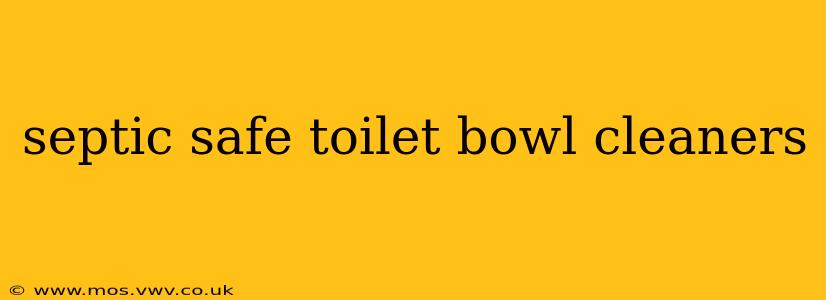Maintaining a clean and functional toilet is crucial for every household, but choosing the right cleaning products is especially important if you have a septic system. Harsh chemicals found in many commercial toilet bowl cleaners can disrupt the delicate bacterial balance in your septic tank, leading to costly repairs and unpleasant consequences. This guide will delve into the world of septic-safe toilet bowl cleaners, helping you make informed choices to keep your toilet sparkling and your septic system thriving.
What Makes a Toilet Bowl Cleaner Septic Safe?
The key to a septic-safe toilet bowl cleaner lies in its ingredients. Avoid products containing harsh chemicals such as:
- Chlorine bleach: This powerful disinfectant kills not only harmful bacteria but also the beneficial bacteria essential for breaking down waste in your septic tank.
- Formaldehyde: A known carcinogen, formaldehyde is often found in some cleaners and is detrimental to both your health and your septic system.
- Strong acids: These can corrode pipes and damage the delicate ecosystem within your septic tank.
- Excessive fragrances and dyes: While these might make your bathroom smell nice, they add unnecessary chemicals that can negatively impact your septic system.
Septic-safe cleaners typically rely on gentler, enzyme-based formulas or utilize naturally occurring ingredients to effectively clean without harming your septic system.
How Do Enzyme-Based Cleaners Work?
Enzyme-based cleaners utilize naturally occurring enzymes that break down organic waste, similar to the bacteria in your septic tank. These enzymes help dissolve stains and remove grime without the need for harsh chemicals. They are a much more environmentally friendly and septic-friendly option.
Are All "Natural" Cleaners Septic Safe?
While many natural cleaners are septic-safe, it's crucial to carefully read the labels. Some "natural" products might contain ingredients that aren't septic-friendly, so always check the manufacturer's claims and ensure they explicitly state the product is suitable for septic systems.
What are the best natural ingredients to use?
Simple solutions often work best. Baking soda and white vinegar are effective and safe for septic systems. A paste of baking soda and water can scrub away stubborn stains, while vinegar's acidity helps to dissolve mineral deposits and kill some bacteria.
What if I Accidentally Used a Non-Septic Safe Cleaner?
If you accidentally used a harsh cleaner, don't panic. Flush the toilet several times to dilute the chemicals. Monitor your septic system for any signs of trouble, such as slow draining, foul odors, or sewage backups. If you notice any problems, contact a septic service professional immediately.
How Often Should I Clean My Toilet Bowl with a Septic-Safe Cleaner?
Regular cleaning helps prevent buildup and ensures your toilet remains hygienic. Aim for cleaning your toilet bowl once a week or as needed, depending on usage.
Are there any other ways to maintain a healthy septic system besides using septic safe cleaners?
Yes! Here are a few additional tips:
- Avoid flushing inappropriate items: Keep wipes, feminine hygiene products, cotton balls, and other non-biodegradable materials out of your toilet.
- Pump your tank regularly: Schedule regular septic tank pumping according to your system’s needs and local regulations.
- Use water wisely: Reduce water waste to minimize the strain on your septic system.
Can I Make My Own Septic Safe Toilet Bowl Cleaner?
Yes, you certainly can! Many simple homemade cleaners are both effective and septic-safe. A mixture of baking soda, vinegar, and essential oils (like tea tree or lemon) is a popular choice. Always test a small amount in an inconspicuous area first to ensure it doesn't damage the toilet bowl's finish.
By making informed choices about your toilet bowl cleaner and following good septic maintenance practices, you can ensure a clean, functional toilet and a healthy septic system for years to come. Remember to always read product labels carefully and consult a professional if you have any concerns.
